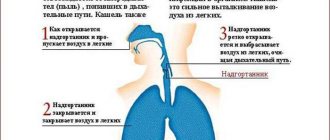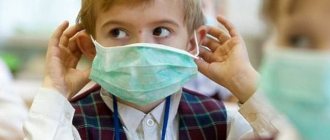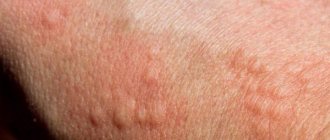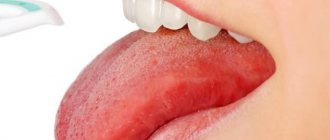An allergy is an exaggerated immune response of the body that occurs when a person comes into contact with a specific allergenic substance.
This exposure may be made by touching, ingestion, or inhalation, depending on the allergic agent.
Agents that can cause it include dust, grass, pollen, cats and dogs, creams, hygiene products, food, and even irritants such as air pollution and other chemicals.
Unlike adults, children are more likely to develop food reactions . In this case, they are not permanent, since they may disappear as the digestive system matures. For example, after six years, allergic reactions to wheat, eggs or milk may disappear. But seafood, fish or nuts usually cause a chronic form.
Causes of allergies in children
The same factors can have different effects on children. Some babies respond to potential allergens with an immune response, others do not. Children are most prone to allergic reactions with:
- parasitic diseases;
- dysbacteriosis;
- weak immunity;
- burdened with an allergic history;
- hereditary tendency to allergic diseases;
- psychosomatic diseases;
- nutritional deficiency or poor diet.
Any product, medication or household chemical can trigger an immune response. The following allergens are considered the most dangerous in terms of reaction development:
- dust and dust mites;
- vaccines;
- mold fungi;
- pollen;
- medications: sulfonamides, antibiotics, local anesthetics;
- food: red vegetables and fruits, nuts, seafood, milk, eggs, legumes, citrus fruits, cereals, honey;
- wasp and bee stings;
- dust mites, cockroaches, animal hair;
- chemicals: washing powders, conditioners, soaps, shower gels, scented shampoos.
There are some features of the disease at different ages. Children in the first year of life are more prone to food and contact allergies (to hygiene products, urine, feces, diapers). Reactions to pollen and pet dander are more common in children aged 2–5 years. Allergies to medications are more common in early and preschool years than in adolescence.
Allergies in newborns in most cases are the result of bad habits or the mother’s failure to comply with a low-allergen diet during pregnancy.
What is an allergy?
Underneath the familiar diagnosis lies a specific disorder of the immune system, in which a number of completely safe substances are recognized by the body as poisons or toxins. Accordingly, the immune system begins to protect the body and produce special antibodies, which are called immunoglobulin E. In turn, these antibodies provoke the production of the hormone histamine. And this hormone leads to the well-known symptoms: rash, itching, runny nose and swelling.
Allergies can have different origins. In some cases, we are talking about a fatal disruption of the immune system. In this case, there is no point in hoping that over time the child will outgrow the allergy. In other cases, there are disturbances in the functioning of other systems, which also lead to excessive production of histamine or its accumulation. In addition, some foods themselves contain this hormone, for example, seafood, or substances that promote its production, for example, chocolate.
Types of allergies. Common allergens
In children, perhaps the most common allergy is food, that is, an acute reaction to food . Allergies to citrus fruits, strawberries, chocolate, honey, nuts, seafood, and eggs are common. But most often, especially in infants, milk allergies occur. Including mother's milk. However, in most cases it does not come to this.
Formula-fed children are especially susceptible to milk allergies The fact is that conventional mixtures are made based on cow's milk, which is indeed an allergen. If there is no way to breastfeed your baby, and the baby is allergic to regular formula, you need to contact your pediatrician so that he can select a specialized formula for allergy sufferers. There are 2 types of specialized mixtures: soy-based and hydrolyzed (processed) milk. As a rule, preference is given to the second type, since soy itself can be a strong allergen.
Do not forget that allergies can be provoked by various chemical additives, such as preservatives, emulsifiers, dyes and flavors. However, most products today contain precisely these substances, and children should not eat from the common table. There is special baby food for them, which does not contain harmful substances.
Food allergies are most common in children under 2 years of age. During this period, the digestive system is developing, the child is constantly introduced to new products, and any of them can cause allergies. The problem of allergies in a child under 1 year of age is especially acute, when even a small amount of allergen in the mother’s diet immediately causes diathesis in the child. The next surge occurs during the introduction of complementary foods, especially if this is not done correctly.
Animal allergies are quite common . It is usually said that an acute reaction is caused by animal fur. Actually this is not true. Allergens are saliva, excrement, and animal skin flakes that stick to the fur and thus spread throughout the apartment. An allergy to a cat in children, as a rule, becomes a real tragedy for children. Unfortunately, in this case the animal will have to be given to relatives or friends.
Strictly speaking, dust is a special case of animal allergy. The situation is approximately the same: the reaction is caused by waste products of dust mites, which live in huge quantities in every home. This is perhaps the most difficult type of allergy, since it is impossible to completely get rid of dust, and contact with the allergen always remains.
After 8 years of age, a child may develop an allergy to pollen . In this case, the disease will be seasonal, and based on the time when problems begin, it can be assumed which group of plants the allergen belongs to. Thus, trees bloom in May, meadow grasses bloom in early summer, and weeds bloom in August and September.
It remains to be mentioned that the child is allergic to insect venom , usually bees and wasps. And also about allergies to medications . These types of allergies are also quite common. Most often, the reaction is caused by drugs of the penicillin group, although in principle, any medication can be an allergen.
Predisposing factors
Unfortunately, medicine still does not know why a child’s immune system suddenly begins to react to completely harmless substances. However, the factors that significantly increase the risk of developing allergies have already been studied quite well. They can all be divided into 4 groups: heredity, ecology, factors affecting the fetus during pregnancy, and factors affecting the child after birth.
Heredity is a very powerful factor. If both parents are allergic, even to different foods and substances, then with a 75-80% probability their child will also suffer from allergies. If this problem is relevant only for one parent, the probability is reduced to 50-30%. Of course, this is not a reason to refuse to have children with allergies, because even if both parents are completely healthy, the risk of an allergic reaction in the child remains.
After all, heredity is not the only and far from the strongest factor. Ecology has no less influence on the body of our children . Moreover, this influence persists at all stages: from the moment of conception and intrauterine development to the very end of life. It is with the deterioration of the environmental situation that scientists attribute the fact that in recent decades the number of children with allergies has been rapidly increasing.
This is not surprising, just imagine what a monstrous cocktail of harmful, potentially harmful and generally safe substances is in the air, water, and food every minute? How can the immune system figure out what it should protect itself from and what it shouldn’t? In this regard, it is especially difficult for the child’s immunity, which is just beginning to form.
A lot of things matter, for example, where the parents lived and worked at the time of conception. If at least one of the two parents worked in hazardous work, the child’s health is already at risk. No less important is the conditions in which the mother lived during pregnancy. The cleaner the air and water, the better the environment, the healthier the baby will be born. Unfortunately, it is not always possible to move to a more favorable area, but it is better to leave the city altogether. In most cases, the woman again simply has to keep in mind the current situation.
In general, the course of pregnancy is one of the most important factors influencing the further development of the child, including the appearance of an allergic reaction to a particular product. Any infectious disease suffered by a pregnant woman can be a decisive factor. Moreover, not only the disease itself affects the fetus, but also the medications used for treatment. Chronic diseases, especially if they are associated with problems with the respiratory system, can also have an impact.
A pathology such as increased permeability of the placenta can cause many diseases in the future, including allergies. A similar effect can be achieved by fetal hypoxia during pregnancy or childbirth.
For a long time, excessive consumption of allergens by the mother during pregnancy was cited as a possible cause for the development of allergies in children. However, now the attitude towards this phenomenon has changed somewhat. Doctors say that if there are no other factors, eating strawberries or seafood alone will not cause allergies in a child. This does not mean that both can be eaten without restrictions. In general, a pregnant woman’s nutrition should fully comply with the motto: “Know when to stop!”
Finally, the time has come to talk about those factors in the development of allergies that have an impact after the birth of a child. Among them, we can note the very fact of constant contact of the child with the allergen . So, as mentioned above, seafood itself contains a large amount of histamine, and excessive consumption of it will sooner or later inevitably cause an allergic reaction in the child. The situation is exactly the same with chocolate, which contains substances that enhance the production of histamine.
Therefore, you need to monitor your child’s nutrition no less than your own nutrition during pregnancy. In addition, it is very important to choose the right cosmetics for children . And also do regular cleaning and do not clutter the children's room with a large number of different dust collectors, such as the beloved canopies, soft toys, furniture, fabric curtains and the like. If any of this is present in the room, it must be cleaned and washed regularly.
However, some scientists also consider the excessive sterility The fact is that the world around us is far from sterile, and when a child goes from a completely disinfected and allergen-free apartment to much less clean rooms, he suddenly encounters a completely new world, and the baby’s immune system is simply not ready for this.
Thus, even when cleaning, it is important to maintain some kind of golden mean. Otherwise, we risk raising a “greenhouse” child who is not adapted to real life. It is not for nothing that in some cases an exacerbation of childhood allergies or its first manifestation occurs precisely after a long visit to new places.
Symptoms and diagnosis
The peculiarity of allergies in a child aged 2 years and earlier is that it can manifest itself very weakly, which makes diagnosis very difficult. In addition, its manifestations are very different. They can be divided into several groups.
The most common allergy symptoms in children are skin manifestations . They are typical for almost any type of allergy. In the simplest and safest version, we are talking only about diathesis - redness of the skin of the cheeks and buttocks. Strictly speaking, this is not even an allergy in the literal sense of the word. This is a message that the child is attracted to her. It is enough to get rid of the allergen at least temporarily, and the symptom will disappear. And it’s not at all a fact that next time the reaction will be the same. This does not mean that diathesis can be taken lightly. But there is no point in panicking.
The next stage is eczema : redness of the skin, the appearance of bubbles and blisters, which are also very itchy. The child becomes restless, cannot sleep, and cries. Eczema is already a reason to take action. You should definitely consult your doctor.
If skin manifestations of allergies particularly affect the face, then angioedema : sudden swelling of the skin, subcutaneous tissue and, most dangerously, the mucous membranes. It blocks the airways, which can lead to death. If your child suddenly finds it difficult to breathe, it could be angioedema. It develops very quickly, so call an ambulance immediately, and also consult with the dispatcher about how and how you can relieve the allergic reaction yourself while the team is on the way.
Manifestations of allergies associated with the respiratory system are no less common. It could be a runny nose, wheezing, or even a cough . Although such symptoms are very common, they are rarely missed and confused with respiratory diseases. If, despite any treatment, a runny nose or hoarse breathing does not go away for a long time, it may be an allergy. Be sure to consult with an allergist.
Allergies to medications can manifest themselves in both ways. In addition, drug allergies are characterized by a symptom such as anaphylactic shock , which, like Quincke's edema, can be fatal. This is why drug allergies are considered one of the most dangerous. In addition, with such an allergy, contact with the allergen is quite rare, and there is a risk of simply forgetting about it. If your child is allergic to medications, do not forget to inform doctors about this so that they take this information into account when prescribing treatment.
The symptoms of allergies in a child are very diverse, which seriously complicates diagnosis. To clarify the diagnosis, doctors will definitely take a blood test for the content of immunoglobulin E.
Possible complications of allergies
Allergy itself, with rare exceptions, is not the most dangerous disease. However, if it is started, much less mild disorders may develop. Thus, untreated childhood eczema can develop into atopic dermatitis. Treatment of this disease is extremely difficult. Fortunately, quite often it goes away on its own by adolescence. However, in rare cases, it stays with a person for life.
In addition, asthma, a dangerous and serious disease, very easily develops against the background of allergies. It is almost impossible to get rid of it. So treating allergies in children is of paramount importance, and it is equally important not to self-medicate. Unfortunately, easy access to antihistamines, as well as the prevalence of the disease, gives parents false confidence that nothing bad is happening. They try to figure out the allergen themselves, and stuff the child with the first pills they come across.
As a result, children with unsuccessful treatment experiences and advanced forms of allergies often come to the doctor.
Types of allergies in children
The most common types of allergies in childhood are:
- Food allergy – occurs as a result of consuming allergenic foods.
- Drug – the reaction of the immune system to taking various medications. Often combined with a food reaction.
- Respiratory - develops when an allergen is inhaled.
- Hay fever, autumn allergies or hay fever - appears annually when certain plants bloom.
- Quincke's edema - can occur in response to a strong food, drug irritant or insect bite.
- Urticaria is an allergic reaction to any skin irritant.
- Cold allergy is a reaction to cold, manifested by difficulty breathing, itching and redness of the skin.
- Sun allergy - develops with prolonged exposure to ultraviolet rays on unprotected children's skin.
- Atopic dermatitis is a manifestation of an immune response on the part of the skin.
- Diathesis – most typical for newborns, appears in the form of diaper rash, scabs on the cheeks, and seborrhea.
Diagnostics
Symptoms can be very varied, so the diagnosis can sometimes be difficult to make.
Keep a diary of your child's foods and symptoms. This will be useful for performing the following tests.
Skin test : For identifying allergies, this is the most common because it is cheap, easy to do, and generally reliable. It is performed by puncturing the skin with a solution of suspicious food. A positive test will give a similar reaction to a low dose.
The disadvantages of this test are that it is inconvenient, and for children with eczema or other skin conditions, the results are difficult to interpret. In children with severe allergies, even small amounts of food introduced into the skin can cause significant reactions.
Another problem with skin testing is that the patient cannot take an antihistamine until about two weeks before the test begins. It is impossible for children with allergic rhinitis or other severe allergies to go two weeks without taking antihistamines.
RAST (radioallergen sorbent) test: This is a blood test that detects specific IgE antibodies in the blood. The body produces immunoglobulin E antibodies in response to allergens. Once these IgE antibodies are constantly circulating in the blood, this test can be performed at any time. The higher the amount of immunoglobulin, the higher the likelihood that a person is allergic to that particular food. The RAST test has the advantage that it is less complex than the skin test and can be done with antihistamines.
The downside of this test (besides the price) is that the results are not as believable as the first ones.
Double Blind Placebo Controlled Test : In this test, the patient has to take capsules containing the suspect and other sugar containing products. Because there is a high risk of a serious, life-threatening reaction, this test is usually done in a clinic or hospital.
One way to find an allergen is to monitor what your child eats and any reactions that occur, which usually occur within two hours of eating. First, suspicious foods are removed from the diet for 1-2 weeks. They are then reintroduced into the diet under medical supervision. It is useful to keep a food diary and the amount of food consumed. This approach will only be approved if the reaction is mild and does not cause breathing problems.
Forecast
Allergy symptoms can range from mild to potentially severe . If you avoid the food or offending ingredients, the allergy may not have much impact on your daily life. Some food allergies disappear as the child grows.
Symptoms and signs of allergies in children
The manifestations of the disease are different, so allergies can easily be confused with a number of other pathologies. Symptoms can occur from the respiratory, digestive system, and skin. Often the reactions of several organs or systems occur together. When exposed to strong allergens, immediate reactions may develop.
Manifestations from the respiratory system
Most often, catarrhal phenomena occur when an allergen enters the respiratory tract. The most common triggers for respiratory allergies are gases, pollen, fine dust and pet dander. Symptoms:
- sneezing;
- rhinitis;
- allergic swelling of the nose;
- itching or burning in the nose;
- suffocation, shortness of breath, obsessive cough;
- wheezing in the lungs;
- bronchial asthma.
How does the reaction manifest on the skin?
Dermatosis is manifested by various irritations and rashes on the skin of any part of the body. More often, allergies appear on the cheeks, buttocks, back, abdomen, hands, legs, head, and around the mouth. Less commonly, rashes can be seen in the groin, on the testicles, armpits, behind the knees, on the palms and soles, and behind the ears. Skin changes are provoked by contact (household chemicals, insect bites), food and drug allergens. Main features:
- hyperemia of the skin;
- itching;
- peeling;
- dryness;
- severe swelling;
- blisters.
What does allergic conjunctivitis look like?
Signs of damage to the mucous membrane of the eyes:
- photosensitivity;
- lacrimation;
- swelling of the eyelids;
- burning in the eyes.
Manifestations from the gastrointestinal tract
Most often they appear with drug and food allergies:
- diarrhea or constipation;
- nausea, vomiting;
- colic;
- swelling of lips, tongue.
Anaphylactic shock
The most dangerous manifestation of allergies. Occurs after an insect bite or taking a medicinal allergen. Symptoms develop from a few seconds to 5 hours from the moment of penetration of the allergen:
- sudden shortness of breath;
- loss of consciousness;
- convulsions;
- rash on the body;
- involuntary defecation, vomiting, urination.
Prevention
If a child has a predisposition to allergies, the following rules must be followed:
- Continue breastfeeding for as long as possible.
- Monitor your baby’s diet and minimize the consumption of potential allergens.
- Close the bookcases.
- Constantly carry out wet cleaning.
- Use air purifiers and humidifiers.
- No smoking indoors.
- Bedding and clothing should be made of hypoallergenic materials.
- Use special household chemicals and hygiene products.
- Regularly treat the apartment with antifungal agents.
- Strengthen the baby's immunity.
Diagnostics: how to find out what your child is allergic to
An allergic reaction is a reason to consult a pediatrician or allergist. To establish a diagnosis and identify the irritant, examination alone is not enough. The disease can be confirmed using various tests and allergy tests:
- Skin tests make it possible to determine the type of allergen in a few minutes.
- Blood test (IgE level) – performed if there are contraindications to skin allergy tests.
- Patch or skin tests help determine the causes of eczema and contact dermatitis.
- Provocative tests are the most effective and reliable research method.
How to diagnose
If allergies are suspected, a diagnosis must be made to identify the causative agent . The test is the most effective tool when the doctor exposes the baby to various allergic agents and then observes the development of symptoms.
However, this test should only be done after the child turns 5 years old. Before this, parents and the doctor should be aware of all the signs of an allergy and try to identify the allergen themselves. This is because blood and urine tests in infants are inconclusive. Most likely, the child's immune system has not yet formed enough allergy antibodies to show up in the test.
For example, if your child is constantly constipated in the spring and fall, with sneezing and a stuffy nose, which does not apply to the rest of the year, then some kind of respiratory allergy may be the cause. If he experiences diarrhea, gas and cramps on certain days after eating, then he may be allergic to that food.
How to cure allergies
Before starting specific treatment, it is necessary to eliminate the allergen. In case of food hypersensitivity, it is necessary to follow a hypoallergenic diet for a nursing woman and an infant. Complementary feeding is postponed for the period of treatment. For bottle-fed children, it is recommended to introduce hypoallergenic formulas.
How to cure allergies: medications
Drug treatment is aimed at eliminating the allergic reaction and reducing its symptoms. The following groups of allergy medications may be used:
- Antihistamines – block or reduce the production of histamine. Available in various dosage forms. Tablets for systemic use, ointments for relieving skin itching and inflammation, drops for the treatment of conjunctivitis or rhinitis of allergic etiology. Names of drugs:
- Loratadine;
- Fenistil;
- Zyrtec;
- Suprastin;
- Eden;
- Tavegil.
- Decongestants are used primarily to combat allergic rhinitis and hay fever. Names:
- Xylometazoline;
- Oxymetazoline.
- Hormonal drugs - used for severe forms of allergies:
- Dexamethasone;
- Prednisolone.
- Homeopathy - drugs are selected exclusively by a homeopathic doctor depending on the type of allergic reaction, the prevailing symptoms, the age of the child and his physiological characteristics. Preparations:
- Sulfur 6;
- Rus 3;
- Belladonna 3, 6;
- Antimonium Crudum 3, 6.
The most effective method of treating the disease is SIT - specific immunotherapy. The method is based on the gradual introduction of increasing doses of the allergen until the body loses sensitivity to it.
Allergy treatment
How to treat allergies in children? First of all, if you suspect that your child has an allergy, be sure to contact your pediatrician and, if necessary, an allergist. The doctor will not only accurately determine whether an allergy occurs, but will also find out what exactly the reaction is to. This is necessary in order to prescribe adequate treatment.
Still, the primary point is to remove the irritant from the child’s environment . Moreover, if we are talking about a breastfed child with a food allergy, then the mother will also have to refuse the dangerous product.
Unfortunately, it is not always possible to completely get rid of an allergen. So, dust is almost omnipresent, and no matter how much you clean it up, it will always be there. The same goes for seasonal pollen allergies. Therefore, it is equally important to choose the right antihistamine.
An antihistamine binds excess histamine, that is, it removes the cause of the allergic reaction. However, first-generation drugs have a huge number of contraindications. In addition, different drugs are effective against different allergens. Therefore, choosing medications on your own is not the best idea. It is possible to permanently “impair” a child’s immunity without achieving the desired result.
Newer drugs do not have as many side effects, and their list of contraindications is much shorter. That is why doctors increasingly prefer them.
Recently, a new method of treating allergies has emerged that allows you to completely get rid of this problem. It is called densensitization . This is absolutely not a medicinal method. Its essence is that the child is gradually, over the course of 5 years, accustomed to the allergen. Start with a small dose and gradually increase it.
Externally, this method looks very simple. Some parents believe that they can handle such a simple task themselves. This could end very badly. The fact is that, firstly, it is very important to correctly calculate the dose of the allergen at each stage, and secondly, the child’s condition must be carefully monitored in order to notice even the smallest manifestations in time and provide assistance.
Thus, any independent treatment of allergies in a child can lead to a worsening of his condition. The main thing is to contact a good specialist in a timely manner. Ideally, to a specialized clinic. However, not every region has such an opportunity. But it is imperative to visit an allergist or pediatrician.
You should especially carefully monitor your child if he is at risk. And for a child without a predisposition to allergies, preventive measures will not hurt. The main thing is to breastfeed your baby for as long as possible. This promotes the development of immunity. In addition, this allows you to keep your child at a distance from quite serious allergens for as long as possible.
In addition, when introducing your child to new products, follow two rules: observe the measure and introduce each product at its own time .
If you cannot avoid allergies, do not panic. Firstly, allergies can be treated quite successfully. Secondly, some types of allergies go away on their own over time. Thirdly, allergies are not a death sentence. If you follow fairly simple rules, your child's life will not be much different from the life of his peers.
Dr. Komarovsky talks about allergy medications
We recommend reading: Features of allergies in babies under one year of age Author
Mama66.ru
Editorial staff of the portal Mama66.ru
All articles by the author
I like!
Treatment
If an allergic reaction is detected, a number of measures must be taken to get rid of the problem.
- In order to eliminate allergy symptoms in children, it is necessary to eliminate exposure to the provoking allergen. A special hypoallergenic diet is prescribed. It is advisable to keep a special food diary and record the introduction of each new product into the child’s diet, and then describe the child’s body’s reaction to it.
- It is necessary to completely exclude nuts, sweets, milk, fish, honey, citrus fruits from the menu - all these products are strong allergens.
- A severe allergy in a child in the acute phase is treated inpatiently. The goal of therapy is to promptly remove toxins from the body, relieve swelling and irritation of the skin, and prevent the development of anaphylactic shock. If we are talking about severe cases, the child may be prescribed a drip to cleanse the blood.
Having an idea of how allergies manifest themselves in children, parents will be able to respond in a timely manner, determine what to do, and how to help their baby. Timely treatment reduces the risk of lifelong allergic reactions.
Diathesis in a 6 year old child, how to treat it
Let us pay special attention to one of the types of allergies in children – diathesis. It usually occurs as a result of inappropriate food and medications. It is worth noting that diathesis is the initial stage of atopic dermatitis. Therefore, any manifestations of it should be taken seriously and consult a doctor.
Diathesis in a six-year-old child? How to treat it? These questions are quite common these days due to the fact that the foods and medications that we use and give to children do not always meet the requirements. And the child’s body is very sensitive and reacts immediately.
The disease most often manifests itself as follows:
- redness, roughness and peeling of the skin of the cheeks;
- itchy rashes on elbows and knees;
- inflammation of the mucous membranes.
The main thing in the treatment of diathesis is adherence to a hypoallergenic diet. Eliminate for a while from your baby’s diet all foods that can cause rashes. And then introduce one product into the menu and observe the body’s reaction. As soon as it appears, immediately eliminate the allergen from the baby’s diet forever. Like all types of allergies, diathesis is treated with the above-mentioned antihistamines, which are taken orally, as well as topical ointments and creams on damaged areas of the skin. As in the treatment of any disease, the main thing when dealing with allergic reactions in children is the timeliness and appropriateness of the selected drugs.
Causes
The causes of allergies can be very different. Some of them are able to accompany a person throughout his life.
In areas that are environmentally unfavorable, with intestinal dysbiosis, in premature babies, as well as in those who face constant somatic diseases, the risk of developing allergies increases significantly.
The immune system reaction can be triggered by the following irritants:
- food;
- plant pollen;
- household dust;
- medications;
- substances included in cosmetics for children;
- proteins contained in animal saliva;
- chemical compounds.
The causes of allergies in children can be very diverse. It is very important to promptly identify the source of such a reaction and eliminate it.












